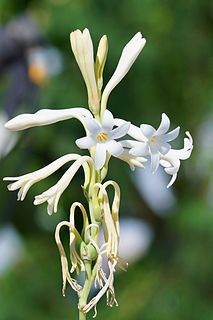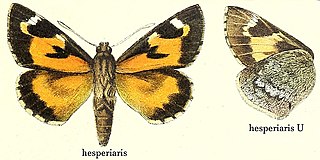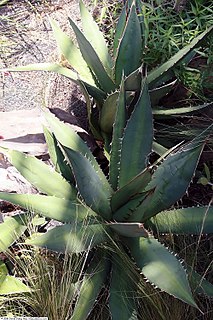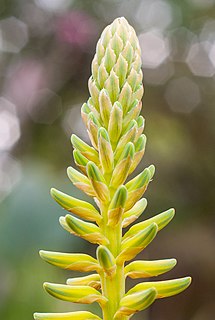Other uses
In music, Maguey also refers to:
- Banda Maguey, a Mexican music band
Maguey may refer to various American plants:
In music, Maguey also refers to:

Mezcal is a distilled alcoholic beverage made from any type of maguey. The word mezcal comes from Nahuatl mexcalli[meʃˈkalːi], which means "oven-cooked agave", from metl[met͡ɬ] and ixcalli[iʃˈkalːi]. Traditionally the word "mezcal" has been used generally in Mexico for all maguey spirits and it continues to be used for many maguey spirits whether these spirits have been legally certified as "mezcal" or not.

Agave americana, common names century plant, maguey, or American aloe, is a species of flowering plant in the family Asparagaceae, native to Mexico and the United States in Texas. It is cultivated worldwide as an ornamental plant, and has been naturalized in many regions, including parts of the West Indies, South America, the southern Mediterranean Basin, Africa, India, China, Thailand, and Australia.

Agave amica, formerly Polianthes tuberosa, the tuberose, is a perennial plant in the family Asparagaceae, subfamily Agavoideae, extracts of which are used as a note in perfumery. Now widely grown as an ornamental plant, the species was originally native to Mexico.

Aegiale hesperiaris is a butterfly commonly known as the tequila giant skipper. It is monotypic in the genus Aegiale. Its caterpillar is one of two varieties of edible "maguey worms" that infest maguey and Agave tequilana plants.

Agave attenuata is a species of agave commonly known as the Foxtail, Lion's tail or Swan's NeckAgave for its development of a curved inflorescence, unusual among agaves. Native to the plateaus of central west Mexico, as one of the unarmed agaves, it is popular as an ornamental plant in gardens in many other places with subtropical and warm climates.

Agave lechuguilla is an Agave species found only in the Chihuahuan Desert, where it is an indicator species. It typically grows on calcareous soils. The plant flowers once in its life and then dies. The flowers are a source of nutrients for insects, bats, and some birds.
Vicina may refer to:

Agave deserti is an agave native to desert regions in southern California, Arizona, and Baja California. Its tall yellow flower stalks dot dry rocky slopes and washes throughout the spring.

A mezcal worm is an insect larva found in some types of mezcal produced in Oaxaca, Mexico. The larva is usually either a gusano rojo or a chinicuil, the caterpillar of the Comadia redtenbacheri moth. The red worm is typically considered tastier.
A. vicina may refer to:

Agave salmiana is a species of the family Asparagaceae, native to central and southern Mexico. It is also reportedly naturalized in South Africa, Italy and Spain, specially in the Canary Islands.

Pulque, or octli, is an alcoholic beverage made from the fermented sap of the maguey (agave) plant. It is traditional in central Mexico, where it has been produced for millennia. It has the color of milk, a rather viscous consistency and a sour yeast-like taste.

Agave is a genus of monocots native to the hot and arid regions of the Americas, although some Agave species are also native to tropical areas of South America. The genus Agave is primarily known for its succulent and xerophytic species that typically form large rosettes of strong, fleshy leaves. Agave now includes species formerly placed in a number of other genera, such as Manfreda, ×Mangave, Polianthes and Prochnyanthes.

Agave schottii, also known by the common name Schott's century plant, is a shrub species within the genus Agave. It is a member of the subgenus Littaea. There are two widely recognized varieties of this species: Agave schotti var. schottii and Agave schottii var. treleasei.

Agave weberi, known as maguey liso in Spanish and as Weber agave in English, is a succulent perennial plant in the family Asparagaceae, subfamily Agavoideae. Under the synonym Agave neglecta, it is known as wild century plant and Small agave – the latter in honor of its discoverer in Florida, John Kunkel Small. Naturalized populations in Florida were considered to be a separate species, but are now treated as synonymous with A. weberi.
Agave gracilipes, common names Maguey de pastizal or slimfoot century plant, is a plant species native to western Texas, southern New Mexico and Chihuahua. It is found in grasslands, desert scrub and open pinyon-juniper woodlands at elevations of 1,200 to 1,900 m.

Agave titanota, the chalk agave, is a species of flowering plant in the family Asparagaceae. It is a medium-sized evergreen succulent perennial native to Oaxaca, Mexico. It often reaches 1-2 feet tall and 2-3 feet wide.

Maguey worms, are one of two species of edible caterpillars that infest maguey and Agave tequilana plants.

The maguey flower, in Spanish, flor de maguey, also known locally as gualumbo, hualumbo, quiote or jiote is a typical product of Mexican cuisine, cultivated mainly in the rural areas of the center of the country. Due to its difficult availability, it is considered a delicacy. Maguey flowers are harvested and consumed closed, since once opened (ripened), they have a bitter taste.